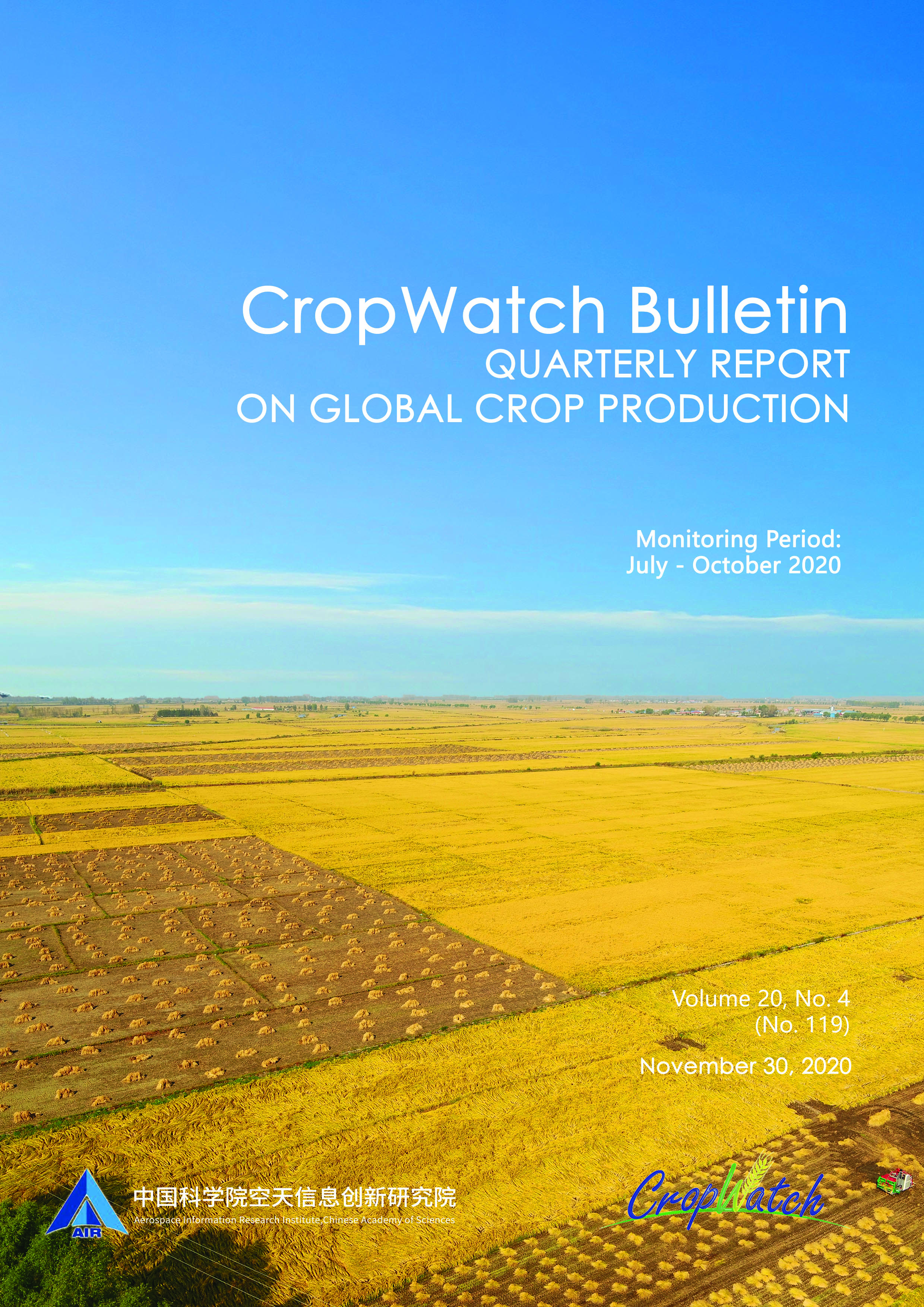
-
November 2020 CropWatch Bulletin is based mainly on current remote sensing inputs in addition to detailed and spatially accurate reference data about crops and their management. Focusing on the months of July to October 2020, chapters cover global, national, and regional level agroclimatic conditions and the condition of crops that were growing during this time. For China, the bulletin presents crop conditions for each of seven key agro-ecological zones. The focus section reports on the estimate by CropWatch for maize, rice, wheat and soybeans production in 2020, recent disaster events with an impact on agriculture, and the possibility of an El Niño event.
Key messages from the report:
- The outbreak of COVID-19 has limited impact on the production of the major crops. Another plague, the outbreak of desert locusts in East Africa, Middle East and southwest Asia is still not under control either.
- Maize production is estimated to increase by 0.8%, wheat by 2,9% and soybean by 0.9%. Rice production remained stable (-0.2%), despite of the heavy floods in the Yangtze river basin in early summer. The north-east was hit by 3 typhoons, causing wind damage and local floods affecting about 1.103 million ha of maize.
- In 2020, global maize production is expected to be at 1.070 billion tons, an increase of 1.4%; global rice production is expected to be 760 million tons at an increase of 0.9%; global wheat production is 738 million tons, an 3.1% increase; global soybean production is expected to be 323 million tons, a slight decrease of 0.2%.
Introduction
This CropWatch bulletin summarizes global crop condition developments and agroclimatic factors from July 1st to October 31, 2020 through 4 zoom in from a global overview of agroclimatic indicators (Chapter 1) to detailed descriptions of crop and environmental conditions in large production zones (Chapter 2), to individual country analyses covering 42 major producers and exporters including agro-ecological zones (Chapter 3) and China (Chapter 4). A special focus section is included in Chapter 5, presents crop production for 2020, disaster events and an update on El Niño. This first part of the report includes the cover, table of contents, abbreviations, a short overview of the different sections of the bulletin and executive summary.DownloadChapter 1. Global agroclimatic patterns
Chapter 1 describes the CropWatch agroclimatic indicators for rainfall (RAIN), temperature (TEMP), and radiation (RADPAR), along with the agronomic indicator for potential biomass (BIOMSS) for sixty-five global Mapping and Reporting Units (MRU). Indicator values for all MRUs are provided in Annex A.DownloadChapter 2. Crop and environmental conditions in major production zones
Chapter 2 presents the same indicators—RAIN, TEMP, RADPAR, and BIOMSS—used in Chapter 1 and combines them with agronomic indicators—cropped arable land fraction (CALF), maximum vegetation condition index (VCIx), and minimum vegetation health index (VHIn)—to describe crop and environmental conditions in six global major production zones (MPZ): West Africa, North America, South America, South and southeast Asia, Western Europe, and Central Europe to western Russia. (See also Annex B for more information about these zones.)DownloadChapter 3. Main producing and exporting countries
Building on the global patterns presented in previous chapters, this chapter assesses the situation of crops in 42 key countries that represent the global major producers and exporters or otherwise are of global or CropWatch relevance. First, the overview section (3.1) pays attention to all countries worldwide, to provide some spatial and thematic detail to the overall features described in section 1.1. In section 3.2, more detail is provided for each of the CropWatch monitored countries, including analyses by key agro-ecological zones within the country. Additional information about indicators per country is provided in Annex A.DownloadChapter 4. China
After a brief overview of the agroclimatic and agronomic conditions in China over the reporting period (section 4.1), Chapter 4 then presents China's crop prospects (section 4.2), describes the situation by region, focusing on the seven most productive agro-ecological regions of the east and south: Northeast China, Inner Mongolia, Huanghuaihai, Loess region, Lower Yangtze, Southwest China, and Southern China (section 4.3). Additional information on the agro-climatic indicators for agriculturally important Chinese provinces is listed in table A.11 in Annex A.DownloadChapter 5. Focus and perspectives
Building on the CropWatch analyses presented in chapters 1 through 4, this chapter presents first early outlook of crop production for 2019 (section 5.1), as well as sections on recent disaster events (section 5.2), and an update on El Niño (5.3).DownloadAnnex A. Agroclimatic indicators
Tables in this Annex provide additional information about the agroclimatic indicators—RAIN, TEMP, and RADPAR—as well as BIOMSS for the various CropWatch spatial units. Those units include the Mapping and Reporting Units (MRU); the forty-three main producing and exporting countries; and regions or provinces within large countries—Argentina, Australia, Brazil, Canada, India, Kazakhstan, Russia, and the United States; and China.DownloadAnnex B. Quick reference guide to CropWatch indicators, spatial units and methodologies
Annex B presents a brief overview of the CropWatch indicators and spatial units (including the MRUs, MPZs, and countries), along with a description of the CropWatch production estimation methodology and methodology to determine the severity of the occurrence.Download

